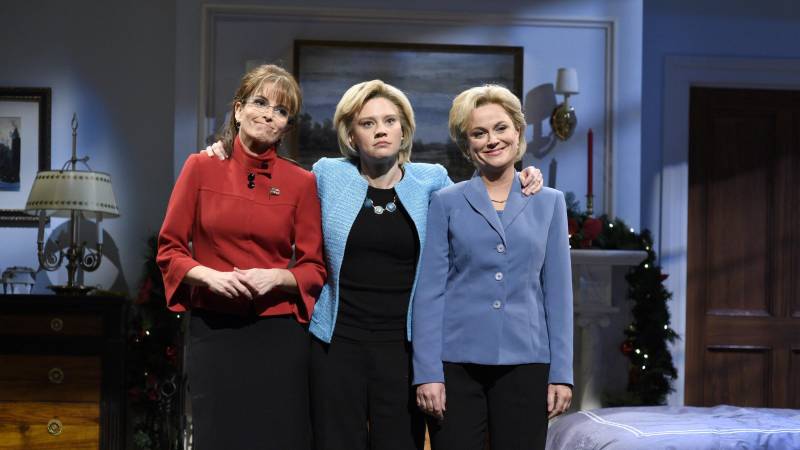Quoting another legendary SNL writer, Jim Downey, he adds, “We just tried to do stuff … that would reward people for knowing stuff, but not punish them for not … Sketches that would be funny to everyone, but we were also trying to put in things that, really, really, smart people could go, ‘Oh I see. They put that in there for me.’”
‘SNL’ shapes our view of politicians through impressions
When Saturday Night Live nails an impression of a politician, it manages a unique alchemy — elevating the thing about that person that is so funny it can pretty much define them in the public’s mind. Often, it is something people already suspected about the politician, crystallizing how the public feels about their policies or candidacies.
When John McCain announced Sarah Palin as his running mate in 2008, Tina Fey produced a devastating take on the vice-presidential candidate as a superficial dimwit given to folksy-sounding word salads in speeches and interviews. Some people even assumed the politician actually said “I can see Russia from my house” — one of the jokes Fey’s Palin announces during a speech that the real Palin never said.
Think Gerald Ford was a clumsy dolt? That might be because that’s how Chevy Chase played him in the show’s first season, even though Ford was a former champion athlete. Aykroyd handled Nixon and Jimmy Carter — nailing Nixon’s shifty villany and Carter’s wide smile and youth appeal, despite wearing a mustache neither politician had. Dana Carvey’s take on George H.W. Bush as a stiff patrician given to flailing his arms widely also led people to confuse Carvey’s jokes with things the real-life president said and did.
And there was Darrell Hammond’s take on Al Gore during a debate sketch in 2000, playing Gore as an oblivious technocrat obsessed with the word “lockbox” to a crushing effect. “I think [that sketch] elected Bush,” says Franken, recalling how Gore’s team reportedly used the sketch to coach the vice president on future debate performances.
But sometimes impressions aren’t enough
Because so much of the show’s political insight comes from impressions, it creates problems when SNL can’t find the right approach. The show never really found a great caricature of Joe Biden, despite having everyone from Jason Sudeikis to Woody Harrelson and Jim Carrey play him.
When I say they had similar problems with Barack Obama, Franken agrees. “[It] was like trying to climb a smooth, vertical wall,” he says of lampooning Obama. “He had nothing to really grab onto. You could do an impression of his voice … but there [weren’t] really a lot of footholds there.”
The problem with Donald Trump may be the opposite: too many footholds. Alec Baldwin nailed Trump’s scowling self-obsession, while James Austin Johnson captures the former president’s stream of consciousness patter, though finding things funnier or more absurd than what he’s actually done in real life remains a challenge.
This weekend at least, Maya Rudolph was ready to nail Harris’ coolly efficient power.
Helping the audience process political ideas beyond impressions
There have been impactful SNL sketches which speak to political ideas beyond lampooning politicians, often in the name of helping the audience process potent ideas.
One of my favorites is a bit from 2016, where Dave Chappelle and Chris Rock are sitting in an election watch party surrounded by white people. As Trump’s election is confirmed, the white folks are shocked that America elected a candidate with such obvious race and sexism issues, while Rock and Chappelle — as Black men familiar with America’s hypocrisies — are not.
When politicians appear as themselves
Particularly before the rise of social media, the best way a politician could try to get ahead of how SNL portrayed them was to appear as themselves in the show’s sketches. Obama, Palin, Hillary Clinton, and even Nikki Haley used this tactic, popping up to look like good sports while pushing back subtly against the most insulting parts of the parodies.
McCain, who called Saturday Night Live creator and showrunner Lorne Michaels a friend, delivered one of the most notable cameos. He kicked off the SNL episode right before the presidential election in November 2008 with an appearance where the senator — flanked by Fey as Palin and his actual wife, Cindy — hawked fake merchandise on the QVC home shopping channel, deftly presaging when Trump would do it for real with his own Bibles and luxury watches.
But one of the most infamous political cameos is also the show’s earliest, when Ron Nessen, then press secretary for Ford, hosted the show in 1976 and got his boss to pre-tape saying the show’s legendary opening phrase, “Live from New York, It’s Saturday Night.”


